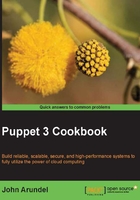
Conventions
In this book, you will find a number of styles of text that distinguish between different kinds of information. Here are some examples of these styles, and an explanation of their meaning.
Code words in text, database table names, folder names, filenames, file extensions, pathnames, dummy URLs, user input, and Twitter handles are shown as follows: "You can check your manifests for style guide compliance using the puppet-lint tool."
A block of code is set as follows:
node 'cookbook' {
cron { 'randomised cron job':
command => '/bin/echo Hello, world >>/tmp/hello.txt',
hour => '*',
minute => random_minute(),
}
}
When we wish to draw your attention to a particular part of a code block, the relevant lines or items are set in bold:
newparam(:path) do
validate do |value|
basepath = File.dirname(value)
unless File.directory?(basepath)
raise ArgumentError , "The path %s doesn't exist" % basepath
end
end
end
Any command-line input or output is written as follows:
ubuntu@cookbook:~/puppet$ papply Notice: Hello, I was included by your ENC! Notice: /Stage[main]/Admin::Helloenc/Notify[Hello, I was included by your ENC!]/message: defined 'message' as 'Hello, I was included by your ENC!' Notice: Finished catalog run in 0.29 seconds
New terms and important words are shown in bold. Words that you see on the screen, in menus or dialog boxes for example, appear in the text like this: "clicking the Next button moves you to the next screen".